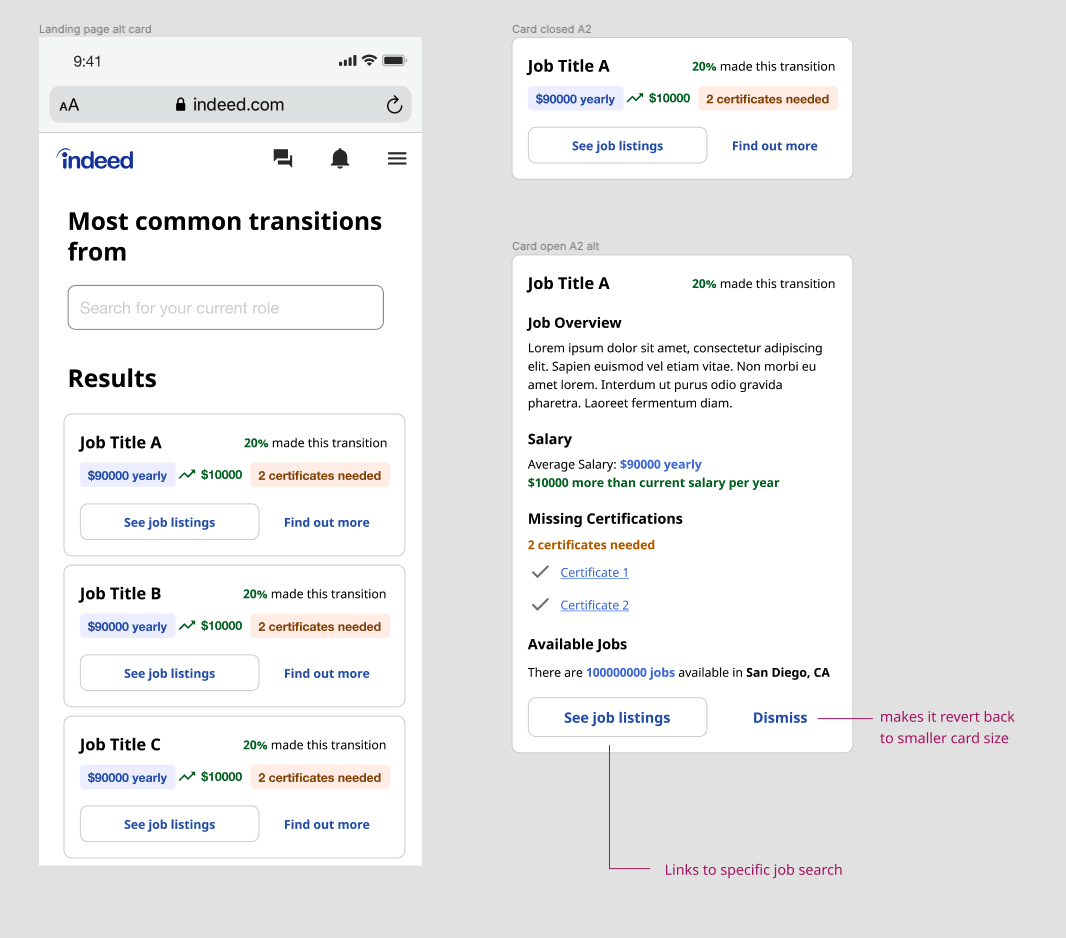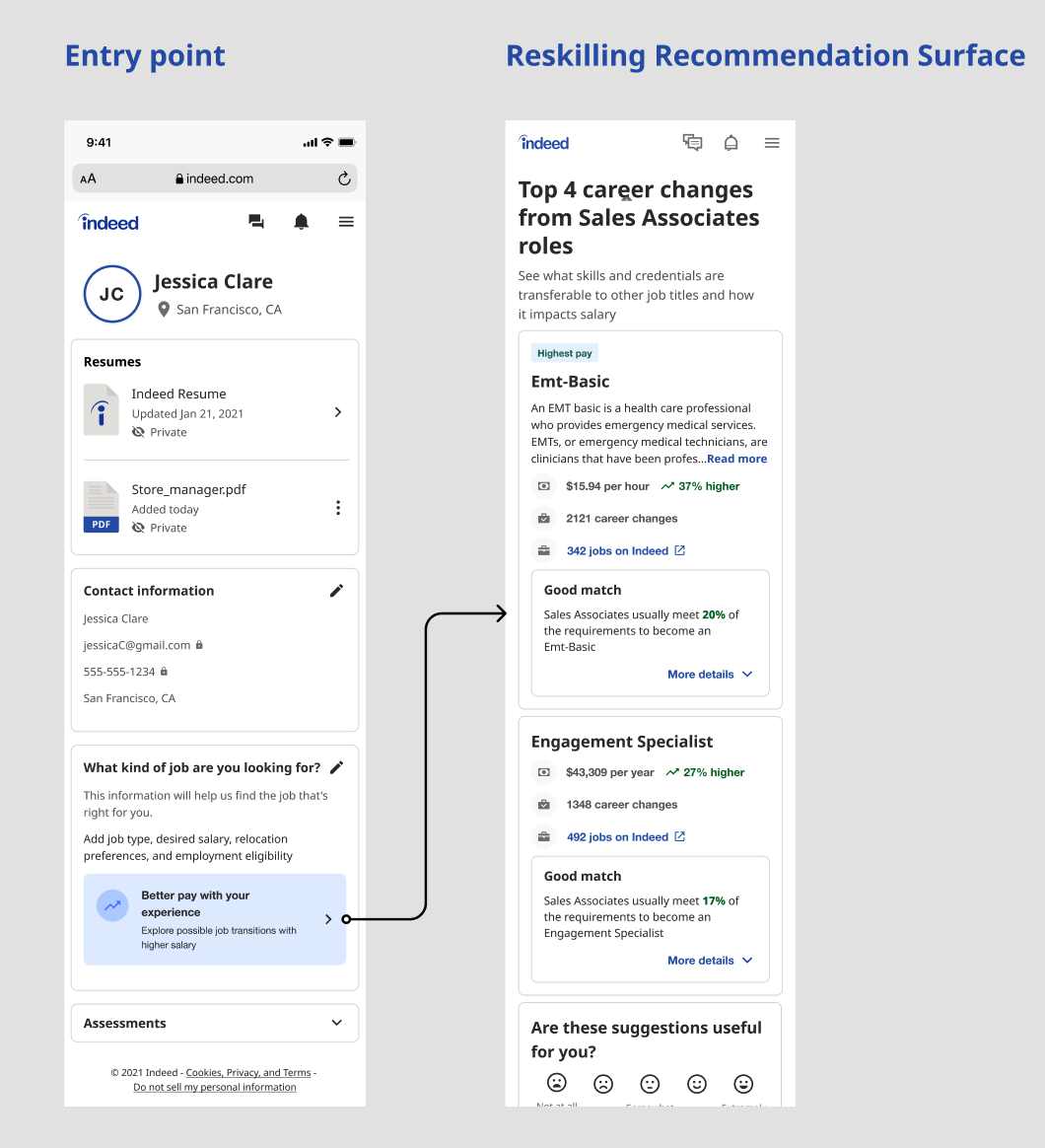
During the summer of 2021, I had an incredible opportunity to work in the Education Discovery team at Indeed as an associate UX designer intern. Detailed below is what I worked on as well as some learnings from this fruitful experience.
Indeed is a company that prides itself in helping people get jobs. The core product being indeed.com where jobseekers can search and apply for jobs. I was part of the education discovery team, which focuses on helping people discover education to enable them to get better jobs.
Reskilling is the process of learning new skills/training new people to do a different job. The World Economic Forum estimates that over half of all employees (54%) will require ‘significant’ reskilling by 2022. This has been further accelerated by the digital transformation brought about by Covid-19. Therefore, we realised that there would be an increasing need to address this skill gap in order to help people get jobs.
For this project, we focused on validating the reskilling hypothesis; namely that there is value in showing potential career transitions to jobseekers if it can be enabled by short term training and thus lead to better jobs.
We compiled initial research based on existing studies done in the past. Subsequently, we also conducted competitive analysis, finding out what competitors in the space had to offer.

Summarised findings slide for competitive analysis deck
The main theme extracted was that competitors can be classified as accommodating for jobseekers who know and don’t know what career to pursue.
This informed the formation of our user stories.
On top of forming the user stories, looking at all the competitors served as inspiration when ideating.
Afterwards, we had an ideation session within the entire team and voted on an idea. My mentor Konrad and I designed some initial Figma mocks and combined ideas. After multiple rounds of feedback and iterations from within Indeed, we settled on a final design.
Initial design (left/first); live product after multiple iterations (right/second)


As the design gets finalised, it was time to test it with users before going live. We did our usability testing on usertesting.com, which was unmoderated. This meant that the screener to recruit participants had to prevent false positives and that instructions for the prototype itself had to be clear. I drafted the usability test plan with reviewing from our UXR Sara, the results informed future iterations of the reskilling surface.
The aforementioned reskilling surface initially drew users in via email. To increase traffic on the surface, we needed more entry points. One such entry point that stood out was the Indeed Profile due to the fact there was data that users visiting the Indeed Profile did not have a desired job title filled out and may be interested in alternative career choices. Therefore, the project objective was to validate the reskilling hypothesis by increasing visibility for reskilling opportunities on Indeed Profile. This informed our user story:
As a jobseeker visiting the Profile section, I would like to explore high(er)-paying careers that can leverage my existing skills and credentials.
Just like other projects, we started by having a kick off meeting to align on objectives, responsibilities and timeline. We also reached out to the profile team to get an initial impression of their thoughts on the project and found out how to go about integrating our entry point with their product.
Afterwards, we took stock of what data and learnings we had from the reskilling surface that can be applied to this project. As the reskilling surfaces’ first entry point was email, we carried out multiple email experiments to test what piece of content was most effective. We found out that jobseekers responded best to content about “Better paying careers”. We carried over these learnings for the content in the profile’s entry point.
We did multiple rounds of iterations as well syncing with key designers in the Profile team and incorporating their feedback each time.
Initial designs explored inserting the banner in different locations of the Indeed Profile. Subsequently, in order to close the loop we wanted to save the career transition as a jobseeker’s desired job title. Setting a desired job title allows jobseekers to get recommendations on jobs based on this desired job title.
Exploring different entry points on Profile (first/left), closing the loop by saving the career transition (second/right)


In the final iteration, we incorporated components provided from the Profile team to ensure there is a consistent way to set the desired job title.

Due to new research that jobseeker’s are apprehensive to set the desired job title, the flow has been simplified to just being the entry point.

I also worked on a few more projects.
First off is to add search functionality for different from titles to the reskilling surface.
The initial design took into account the minimum amount of use cases as this was an MVP feature.

The design went through a few minor changes before being implemented and deployed live on Indeed.


Concurrently, I also helped our UXR with analysing existing interviews to come up with user archetypes. There were other projects I worked on as well that are still waiting to be implemented.
For the profile entry point, we had to collaborate with the Profile team in the US. Being based in Singapore, the time difference was night and day, making the back and forth long and tiresome.
To get around this, we optimised our asynchronous communication and minimised meetings. We used clarification documents, where I could dump all the possible questions to be answered in 1 go. As the design got more finalised, a collaboration slack channel was also established between the 2 teams.
There were a couple of incidents where I didn’t check my work before proceeding, wasting some time and effort. For example, the profile entry point initially suggested certifications instead of being an entry point to the surface. This was due to my misunderstanding of the scenario being prioritised at that point in time.
To overcome this, I’ve started making checklists on my task manager to go through before submitting work.
Last but not least, working on all these projects and having my designs critiqued has improved my craft drastically. I’ve learnt to take note of edge cases when designing, account for accessibility especially with colour contrast, ensure my designs are balanced by using a 4pt grid, and consider the user’s context when writing content.
To maximise my time, I’ve also worked on side projects/design exercises for further practice in solving UX problems and producing designs.
I’ve also learnt a lot about collaboration with stakeholders from research, design, content, product management and engineering. Mainly to properly kickoff new projects by aligning everyone on the same problem statement, responsibilities as well as timelines.
It was a great summer at Indeed, I’ve learnt a lot from everyone at the Education Discovery team and the SG UX team. Special thanks go out to my mentor Konrad, Sara the UX researcher and Masako the content strategist, for working closely with me and guiding me along the way.
